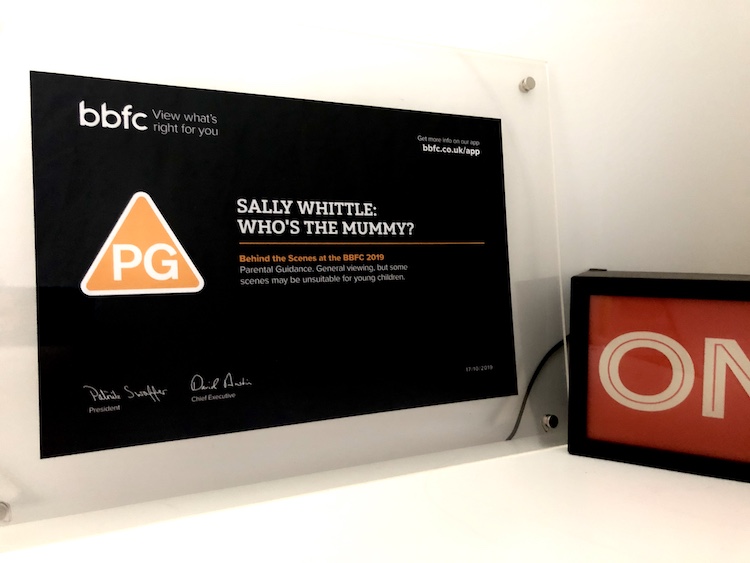 How to Manage What Kids Watch Online isn’t a sponsored post, but I did get a cool gift at my meeting with BBFC.
How to Manage What Kids Watch Online isn’t a sponsored post, but I did get a cool gift at my meeting with BBFC.
I remember the first time I saw Dirty Dancing.
I was 13, and sneaking in to see the film, which was rated ’15’.
There was a cunning plan to make sure that I would seem older. This included memorising a fake date of birth, wearing my favourite SUPER cool parachute pants, and casually talking weirdly loudly to my friend Sophie about other 15-certificate films we’d seen. Meanwhile Sophie made sure to mention smoking a lot (neither of us smoked).
As it turned out, the cashier couldn’t have cared less, and we spent a happy evening swooning over Patrick Swayze.
It worked, and life was never the same after watching what happened to Baby after she carried the watermelon.
Age Ratings in the Digital Generation
Ah, kids today. They may never know the joy of sneaking into a 15-certificate movie. For starters, there’s now a 12-certificate for films like Dirty Dancing.
More importantly, though, our teens go to the cinema less than ever. Most of the films and box sets that my teen watches are online. She watches horror movies and endless box sets on YouTube, Sky TV, Netflix, Apple TV and various social media platforms.
It’s a worry, isn’t it? And by worry I mean “endlessly terrifying”. Because while there’s a lot of Peppa Pig online, there’s also a lot of NOT Peppa.
According to the British Board for Film Classification, almost a third of TV programmes and original content streamed online carry no age rating. Lots of platforms use different rating info for TV, films and original content. That’s making life hard for parents trying to manage what kids watch online.
The Role of the BBFC
The BBFC takes on the mammoth task of giving certificates to ALL UK cinema films, as well as DVD and Blu-Ray. They have just updated their ratings to be used on online platforms, too.
From this month, Netflix will start rolling out the familiar BBFC ratings to all content on its platform. These ratings are also being used on Amazon Prime, iTunes and Sky Store, among others. The BBFC hopes more providers will adopt these ratings for their content, soon.
Having consistent age ratings would make life easier. I’ve lost count of the number of times I’ve started watching something online with Flea, and then turned it off, horrified, halfway through!
It’s not necessarily that I don’t let Flea watch 15 or 18-rated content. But an 18 rating flags to me that I should check out the film before deciding whether to let Flea watch. You can pop any film title into this page on the BBFC website for detailed information about the film’s content – particularly things like violence, sex, language, threat and horror. Very handy.
How are Age Ratings Worked Out?
I was invited to the BBFC headquarters in London to find out more about the UK’s age rating system. I learned so much cool film trivia, and it made me very happy. I also was given this lovely souvenir! I’m so pleased I’m rated PG, because I like to think I’m still cool.

Did you know that scary films are often classified younger in America versus the UK? That’s because the US doesn’t take account of how scary a film *feels*, only what you see on screen?
Conversely, films with sexy scenes are way less likely to be allowed for younger kids in the US versus the UK. We are more relaxed about such things. UK audiences tend to be more offended by violence than sex, while the reverse is true in the US.
The day was also an opportunity to pass on Flea’s recommendation that the UK follows the US in allowing children to go to see 18-rated movies if they are accompanied by an adult. (In the US, children can see an R-rated movie if they’re with a parent). Sadly, David Austin, the BBFC’s chief executive, wasn’t down with Flea’s plan…
Broadly speaking, classifications are based on how a film features things like dangerous behaviour, drugs, bad language, nudity, sex, violence and threat/horror. Someone at BBFC watches every film and decides how much of this sort of stuff is featured, in what detail, for what time and in what context. On that basis, a film is awarded an age-rating.
It’s not just down to that one guy, though. Every few years the BBFC surveys 10,000 members of the public, showing them clips of various films and asking for feedback on how they view certain types of content. After all, what was shocking in 1930 might be completely tame in 2019.
Ultimately, age classifications are there for us – you should know that if there’s an injury in a U-rated film, it’s likely to be trivial or obviously not real (like a LEGO mini-figure toy being beheaded). If there’s violence in a 12A-rated film, it might be fleeting, and the film won’t focus on the injured victim or show too much blood. In a PG-rated film, that violence will be much milder, and may only be shown if it’s in a historical, comedic or fantasy context).
It was such an interesting thing to learn about, and all the info is available online.
How to Manage what Kids Watch Online
If you’re concerned about your children watching inappropriate content online, then age-ratings are a useful guide. You can also use parental controls to manage what kids watch online. I’ve provided links below to information on how to set parental controls on the major streaming services:
Now TV: see how to set a parental pin
Amazon Prime: Use your account restrictions to set parental controls
Netflix: how to create a PIN for restrictionsPIN for restrictions
Sky TV: set up family mode or parental controls
Apple TV: set up restrictions in the parental control settings




